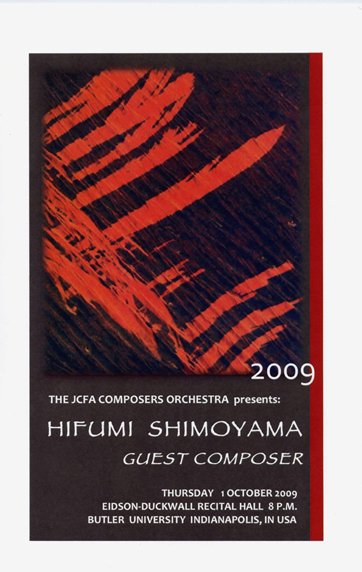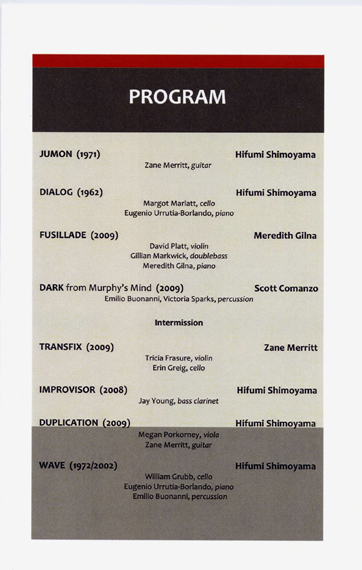下山一二三 in インディアナポリス


Conversation with Hifumi Shimoyama
by Brooks Frederickson
Japanese composer Hifumi Shimoyama is one of the most original sounding composers living today. His use of extended techniques, ambivalence to any and all musical "rules", and vivid aesthetics give a freedom to his music not found anywhere else.
Mr. Shimoyama is in residence this week at Butler University. He sits across the table from me, his wife on his left and, on his right, sits Miho Sasaki (a Butler grad with a Masters in Composition, who is acting as translator). Nana Omori (a pianist working towards her Masters at Butler, also acting as translator) sits on my left.
Mr. and Mrs. Shimoyama, fresh off their 11-hour flight from Japan looked surprisingly alert.
Shimoyama was born in 1930 in Hirosaki City, a city at the north end of the Honshu, the main island of Japan. A place that Shimoyama describes as having "lots of snow and not much color. It was a celebration to see the color green come back every Spring."
He took up the violin when he was young, "because it was the least expensive instrument" before moving to piano — "but I'm no virtuoso" he is quick to add.
One theme that comes up regularly in our conversation is his musical independence. No one in his house was a musician, he didn't go to a music-specific school, and he didn't have a composition teacher until he was 25. For anyone else, these conditions would have been the end of their musical career. But to Shimoyama, they are what set him apart. "(In schools) composers start to sound like the other composers… I didn't go to music schools, I did it myself. I came up with my ideas."
Sometimes not having a teacher to guide him caused Shimoyama to not know the historical facts behind what he was listening to. When he first heard Hungarian composer Bela Bartok, Shimoyama thought Bartok had come up with the jaunty, mixed meter idea himself. When in reality, Bartok had taken it from the Hungarian folk tunes he had transcribed. When Shimoyama found out Bartok used folk-tunes from his native country, Shimoyama decided to look at Japan's folk-tunes for inspiration.
Around the same time, Shimoyama first heard Anton Webern, a student of the "Second Viennese School," a school based around the highly controlled serial method of music composition. In Webern, Shimoyama found a different approach to music, one not present in folk-tunes.
The first, and only, teacher Shimoyama studied with was composer Yoritune Matsudaira. Shimoyama moved to Tokyo when he was 25 to study with Matsudaira, who was "the only teacher worth studying with at the time." Shimoyama adds, "Matsudaira was a great teacher, he taught his students not to copy him."
By the time Shimoyama started his career as a composer, he had tried the strict serial method of Webern and the "Second Viennese School" only to find it too constraining. "I hate being controlled by music theory. I started using twelve-tone music for five years, before abandoning it for my own style… I started out with all the theories, but felt something different. I wanted to try my own way." he adds, "…I don't want to write pieces you can explain with music theory."
Shimoyama sees his music as an emotional expression, one that he doesn't like to have to define. When I asked him if this explained the small size of the program notes for his pieces he replied, "absolutely." Shimoyama pours his emotions into his music, one of the strongest points he makes during the interview is "If the music doesn't touch my heart, then I don't want to create it."
I was interested in hearing his opinion on how musicians of this generation compared to musicians of previous generations that he has worked with. He replied, "In the past 20 years the skill level has gotten higher. I can write any difficult thing and it can get played. When I was in my 20's, so many players refused to play my music because they couldn't play it… but now it's no problem."
To meet Mr. Shimoyama and to hear his music, be at Eidson-Duckwall Recital Hall, Butler University Thursday October 1st at 8:00pm; admission is free.
